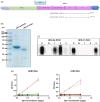Rat hepatitis E virus (Rocahepevirus ratti) exposure in cats and dogs, Hong Kong
- PMID: 38551320
- PMCID: PMC11018080
- DOI: 10.1080/22221751.2024.2337671
Rat hepatitis E virus (Rocahepevirus ratti) exposure in cats and dogs, Hong Kong
Abstract
Hepatitis E virus (HEV) variants infecting humans belong to two species: Paslahepevirus balayani (bHEV) and Rocahepevirus ratti (rat hepatitis E virus; rHEV). R. ratti is a ubiquitous rodent pathogen that has recently been recognized to cause hepatitis in humans. Transmission routes of rHEV from rats to humans are currently unknown. In this study, we examined rHEV exposure in cats and dogs to determine if they are potential reservoirs of this emerging human pathogen. Virus-like particle-based IgG enzymatic immunoassays (EIAs) capable of differentiating rHEV & bHEV antibody profiles and rHEV-specific real-time RT-PCR assays were used for this purpose. The EIAs could detect bHEV and rHEV patient-derived IgG spiked in dog and cat sera. Sera from 751 companion dogs and 130 companion cats in Hong Kong were tested with these IgG enzymatic immunoassays (EIAs). Overall, 13/751 (1.7%) dogs and 5/130 (3.8%) cats were sero-reactive to HEV. 9/751 (1.2%) dogs and 2/130 (1.5%) cats tested positive for rHEV IgG, which was further confirmed by rHEV immunoblots. Most rHEV-seropositive animals were from areas in or adjacent to districts reporting human rHEV infection. Neither 881 companion animals nor 652 stray animals carried rHEV RNA in serum or rectal swabs. Therefore, we could not confirm a role for cats and dogs in transmitting rHEV to humans. Further work is required to understand the reasons for low-level seropositivity in these animals.
Keywords: Hepatitis E virus; cat diseases; dogs; hepatitis antibodies; rats.
Conflict of interest statement
No potential conflict of interest was reported by the author(s).
Figures




References
MeSH terms
Substances
LinkOut - more resources
Full Text Sources
Other Literature Sources
Miscellaneous
